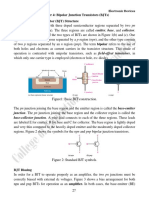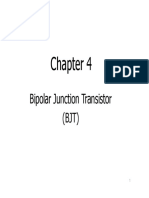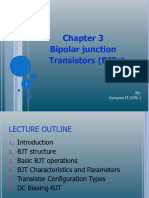IV. Bipolar Junction Transistors: LED 10302: Introduction To Electronics Meet Prepared By: AZO, AZJ, ATA, MSH
IV. Bipolar Junction Transistors: LED 10302: Introduction To Electronics Meet Prepared By: AZO, AZJ, ATA, MSH
Uploaded by
Naim NizamCopyright:
Available Formats
IV. Bipolar Junction Transistors: LED 10302: Introduction To Electronics Meet Prepared By: AZO, AZJ, ATA, MSH
IV. Bipolar Junction Transistors: LED 10302: Introduction To Electronics Meet Prepared By: AZO, AZJ, ATA, MSH
Uploaded by
Naim NizamOriginal Title
Copyright
Available Formats
Share this document
Did you find this document useful?
Is this content inappropriate?
Copyright:
Available Formats
IV. Bipolar Junction Transistors: LED 10302: Introduction To Electronics Meet Prepared By: AZO, AZJ, ATA, MSH
IV. Bipolar Junction Transistors: LED 10302: Introduction To Electronics Meet Prepared By: AZO, AZJ, ATA, MSH
Uploaded by
Naim NizamCopyright:
Available Formats
UniKL MIMET Page 1 out of 9
IV. Bipolar Junction Transistors
4.0 Introduction
– Popular belief holds that the bipolar junction transistor (BJT) was developed by
Schockley, Brattain, and Bardeen from Bell labs in 1948.
– This is not true, as the device invented was the point-contact transistor.
– BJTs were actually developed in the late 1951’s by Dr. Schockley.
– The transistor is a three-terminal device whose output current, voltage and/or power
are controlled by its input current.
– Used primarily in communication as an amplifier to increase the strength of an ac
signal.
– In digital systems it is primarily used as a switch.
4.1 Transistor Structure
– The BJT is constructed with three doped semiconductor regions separated by two pn
junctions.
– The three regions are called emitter, base, and collector.
– There are two types of BJTs, either pnp (two p regions separated by one n region)
and npn (two n regions separated by one p region).
– The C, B, and E symbols represent the common, emitter, and base regions,
respectively.
– The base region is lightly doped and very thin compared to the heavily doped emitter
and moderately doped collector regions.
LED 10302: Introduction to Electronics MEET
Prepared by: AZO, AZJ, ATA, MSH
UniKL MIMET Page 2 out of 9
4.2 Basic Transistor Operation
– For correct operation, the two pn junctions must be correctly biased with external dc
voltages.
– Operation of the pnp is similar as that of npn, but the roles of electrons and holes,
bias polarities, and current directions are all reversed.
– The figure below shows the correct biasing of a BJT.
– Note the base-emitter (BE) junction is forward biased and the base-collector (BC)
junction is reverse biased.
– The forward bias from base to emitter narrows the BE depletion region.
– The reverse bias from base to collector widens the BC depletion region.
– The heavily doped n-type emitter region is packed with conduction-band (free)
electrons.
– The free electrons from the emitter diffuse easily through the forward biased BE
junction into the p-type base region
– In the base, the electrons become minority carriers (like in a forward biased diode).
– The base region is lightly doped and very thin, so it has a limited number of holes.
– Because of that light doping, only a small percentage of all the electrons flowing
through the BE junction can combine with the available holes in the base.
– These relatively few recombined electrons flow out of the base lead as valence
electrons, forming the small base electron current.
– Most of the electrons flowing from the emitter into the lightly doped base region do
not recombine, but diffuse into the BC depletion region.
– Once here, they are pulled through the reverse-biased BC junction by the electric
field set up by the force of attraction between the positive and negative ions.
– Electrons now move through the collector region, out through the collector lead, and
into the positive terminal of the collector voltage source.
– This forms the collector electron current. The collector current is much larger than
the base current.
– This is the reason transistors exhibit current gain.
– From graph above:
IE = IC + IB
– Capital letters indicate dc values.
LED 10302: Introduction to Electronics MEET
Prepared by: AZO, AZJ, ATA, MSH
UniKL MIMET Page 3 out of 9
4.3 Transistor Characteristics and Parameters
– The ratio of the dc collector current (IC) to the dc base current (IB) is the dc beta
(DC).
– DC is called the gain of a transistor:
DC = IC/IB
– Typical values of DC range from less than 20 to 200 or higher.
– DC is usually designated as an equivalent hybrid (h) parameter:
hFE =DC
– The ratio of the collector current (IC) to the dc emitter current (IE) is the dc alpha
(DC). This is a less-used parameter than beta.
DC = IC/IE
– Typical values range from 0.95 to 0.99 or greater.
– DC is always less than 1.
– This is because IC is always slightly less than IE by the amount of IB.
– From graph above we can see that there are 6 important parameters to be considered:
i) IB: dc base current.
ii) IE: dc emitter current.
iii) IC: dc collector current.
iv) VBE: dc voltage at base with respect to emitter.
v) VCB: dc voltage at collector with respect to base.
vi) VCE: dc voltage at collector with respect to emitter.
– VBB forward-biases the BE junction.
– VCC reverse-biases the BC junction.
– When the BE junction is forward biased, it is like a forward biased diode:
VBE ≈ 0.7 V
– But it can be as high as 0.9 V (and is dependent on current). We will use 0.7 V from
now on.
– Emitter is at ground. Thus the voltage across RB is
VR(B) = VBB- VBE
LED 10302: Introduction to Electronics MEET
Prepared by: AZO, AZJ, ATA, MSH
UniKL MIMET Page 4 out of 9
– Also:
VR(B) = IRRB
– Or:
IRRB = VBB- VBE
– Solving:
IB = (VBB- VBE)/RB
– Voltage at collector with respect to grounded emitter is:
VCE = VCC – VR(C)
– Since drop across RC is VR(C) = ICRC the voltage at the collector is also:
VCE = VCC - ICRC
– Where IC = DCIB. Voltage across the reverse-biased collector-bias junction is
VCB = VCE - VBE
Example:
Determine IB, IC, IE, VBE, VCE, and VCB in the following circuit. The transistor has DC
150.
Rc
100Ohm
Vcc
Rb 10V
10kOhm
Vbb
5V
Solution:
We know VBE=0.7 V. Using the already known equations:
IB = (VBB- VBE)/RB
IB = (5 – 0.7)/10k = 430 A
IC = DCIB = (150)( 430 A) = 64.5 mA
IE = IC + IB = 64.5 mA + 430 A = 64.9 mA
Solving for VCE and VCB:
VCE = VCC – ICRC = 10V-(64.5mA)(100 = 3.55 V
VCB = VCE – VBE = 3.55 V – 0.7 V = 2.85 V
Since the collector is at higher potential than the base, the collector-base junction is
reverse-biased.
LED 10302: Introduction to Electronics MEET
Prepared by: AZO, AZJ, ATA, MSH
UniKL MIMET Page 5 out of 9
– Changing the voltage supplies with variable voltage supplies in the circuit above, we
can get the characteristic curves of the BJT.
– If we start at some positive VBB and VCC = 0 V, the BE junction and the BC junction
are forward biased.
– In this case the base current is through the BE junction because of the low impedance
path to ground, thus IC is zero.
– When both junctions are forward-biased, the transistor is in the saturation region of
operation.
– As VCC is increase, VCE gradually increases, as the IC increases (This is the steep
slope linear region before the small-slope region).
– IC increases as VCC increase because VCE remains less than 0.7 V due to the forward-
biased base-collector junction.
– Ideally, when VCE exceeds 0.7 V, the BC junction becomes reverse biased.
– Then, the transistor goes into the linear region of operation.
– When the BC junction is reverse-biased, IC levels off and remains essentially
constant for a given value of IB as VCE continues to increase.
– Actually, there is a slight increase in IC, due to the widening of the BC collector
depletion region, which results in fewer holes for recombination in the base, which
causes a slight increase in DC.
– For the linear portion, the value of IC is calculated by:
IC = DCIB
– When VCE reaches a sufficiently large voltage, the reverse biased BC junction goes
into breakdown.
– Thus, the collector current increases rapidly.
– A transistor should never be operated in this region.
– When IB = 0, the transistor is in the cutoff region, although there is a small collector
leakage current.
LED 10302: Introduction to Electronics MEET
Prepared by: AZO, AZJ, ATA, MSH
UniKL MIMET Page 6 out of 9
i) Cutoff
– As said before, when IB = 0, transistor is in cutoff region.
– There is a small collector leakage current, ICEO.
– Normally it is neglected so that VCE = VCC.
– In cutoff, both the base-emitter and the base-collector junctions are reverse-
biased.
ii) Saturation
– When BE junction becomes forward biased and the base current is increased, IC
also increase (IC – DCIB) and VCE decreases as a result of more drop across the
collector resistor (VCE = VCC – ICRC).
– When VCE reaches its saturation value, VCE(sat), the BC junction becomes
forward-biased and IC can increase no further even with a continued increase in
IB.
– At the point of saturation, IC = DCIB is no longer valid.
– VCE(sat) for a transistor occurs somewhere below the knee of the collector curves.
– It is usually only a few tenths of a volt for silicon transistors.
LED 10302: Introduction to Electronics MEET
Prepared by: AZO, AZJ, ATA, MSH
UniKL MIMET Page 7 out of 9
iii) DC load line
– Cutoff and saturation can be illustrated by the use of a load line.
– Bottom of load line is at ideal cutoff (IC = 0 and VCE = VCC).
– Top of load line is at saturation (IC = IC(sat) and VCE = VCE(sat))
– In between cutoff and saturation along the load line is the active region.
– More to come later.
Example
Determine whether or not the transistor in circuit below is in saturation. Assume
VCE(sat) = 0.2 V.
Rc
1kOhm
Vcc
Rb 10V
gain=50
10kOhm
Vbb
3V
First determine IC(sat) .
IC(sat) = (VCC – VCE(sat))/RC
IC(sat) =(10 V – 0.2V)/10k = 9.8 mA
Now let’s determine whether IB is large enough to produce IC(sat).
IB = (VBB - VBE)/RB = (3 V – 0.7 V)/10k = 0.23 mA
LED 10302: Introduction to Electronics MEET
Prepared by: AZO, AZJ, ATA, MSH
UniKL MIMET Page 8 out of 9
IC = DCIB = (50)(0.23 mA) = 11.5 mA
This shows that with the specified DC, this base current is capable of producing an
IC greater than IC(sat) . Thus, the transistor is saturated, and the collector current
value of 11.5 mA is never reached. If you further increase IB, the collector current
remains at its saturation value.
iv) More on DC
– The DC of hFE is not truly constant.
– It varies with collector current and with temperature.
– Keeping the junction temperature constant and increasing IC causes DC to
increase to a maximum.
– Further increase in IC beyond this point causes DC to decrease.
– If IC is held constant and temperature varies, DC changes directly with
temperature.
– Transistor data specify DC at specific values. Normally the DC specified is the
maximum value.
v) Maximum transistor ratings
– Maximum ratings are given for collector-to-base voltage, collector-to-emitter
voltage, emitter-to-base voltage, collector current, and power dissipation.
– The product VCEIC must not exceed PD(max).
Example:
The transistor shown in the figure below has the following maximum ratings:
PD(max)=800 mW, VCE(max) = 15 V, and IC(max) = 100 mA. Determine the maximum value
to which VCC can be adjusted without exceeding a rating. Which rating would be
exceeded first?
Rc
1kOhm
Vcc_Variable
Rb
gain=100
22kOhm
Vbb
5V
Solution:
First, find IB, so that you can determine IC.
IB = (VBB – VBE)/RB = (5 V – 0.7 V)/22 k = 195 A
IC = DCIB = (100)(195 A) = 19.5 mA
IC is much less than IC(max) and will not change with VCC. It is determined only by IB and
DC.
LED 10302: Introduction to Electronics MEET
Prepared by: AZO, AZJ, ATA, MSH
UniKL MIMET Page 9 out of 9
The voltage drop across RC is
VR(C) =ICRC = (19.5 mA)(1 k) = 19.5 V
Now we can determine the value of VCC when VCE = VCE(max) = 15 V.
VR(C) = VCC - VCE
So,
VCC(max) = VCE(max) + VR(C) = 15 V + 19.5V = 34.5 V
VCC can be increased to 34.5 V, under the existing conditions, before VCE(max) is
exceeded. However, at this point it is not known whether or not PD(max) has been
exceeded:
PD = VCE(max)IC = (15 V)(19.5 mA) = 293 mW
Since PD(max) is 800 mW, it is not exceeded when VCC = 34.5 V. So, VCE(max) = 15 V is the
limiting rating in this case. If the base current is removed, causing the transistor to turn
off, VCE(max) will be exceeded first because the entire supply voltage, VCC, will be dropped
across the transistor.
Chapter Summary
– BJTs have three regions: base, collector, and emitter.
– BJTs have two pn junctions: base-emitter, and base-collector.
– Current in a BJT consists of both free electrons and holes, thus the term bipolar.
– Base is lightly doped compared to emitter and collector.
– There are two types of BJTs: npn and pnp.
– To operate as amplifier, the BE junction must be forward-biased and BC junction must
be reverse-biased (forward-reverse bias).
– IB is very small compared to IC and IE.
– The dc current gain is DC = IC/IB.
– When a BJT is forward-reverse biased, the voltage gain depends on the internal emitter
resistance and the external collector resistance.
– A transistor can be operated as a switch in cutoff and saturation.
– In cutoff, both pn junctions are reverse-biased. Thus no IC. Therefore, there is an open
between collector and emitter.
– In saturation, both pn junctions are forward-biased and the collector current is maximum.
Behaves like a closed switch between collector and emitter.
LED 10302: Introduction to Electronics MEET
Prepared by: AZO, AZJ, ATA, MSH
You might also like
- EE-513-Updated-10-9-17 (1Document16 pagesEE-513-Updated-10-9-17 (1Victor DoyoganNo ratings yet
- BJT CB CC CeDocument25 pagesBJT CB CC Ceashishpatel_990% (1)
- Bipolar Junction TransistorsDocument26 pagesBipolar Junction TransistorsEng Abdulkadir MahamedNo ratings yet
- Chapter 4Document45 pagesChapter 4api-394738731No ratings yet
- Elec 9Document29 pagesElec 9abdalrahim124No ratings yet
- Bipolar Junction TransistorsDocument55 pagesBipolar Junction Transistorshuy PhamNo ratings yet
- BJT SummaryDocument65 pagesBJT SummaryRutendo SedeyaNo ratings yet
- Bipolar Junction Transistors Lecture 2 BJT 1 RevADocument30 pagesBipolar Junction Transistors Lecture 2 BJT 1 RevAKoh Jiun HaoNo ratings yet
- 11-BJT DC Characteristics and Analysis-20!02!2024Document15 pages11-BJT DC Characteristics and Analysis-20!02!2024ashbinny1No ratings yet
- EdcDocument21 pagesEdcThiaga RajanNo ratings yet
- AnalogEl 1 BTJDocument33 pagesAnalogEl 1 BTJAlbert GenceNo ratings yet
- I. Basic BJT Application & DC BiasingDocument20 pagesI. Basic BJT Application & DC BiasingNaim NizamNo ratings yet
- Bipolar Junction TransistorDocument28 pagesBipolar Junction TransistorRAFAEL ALCARAZNo ratings yet
- Lecture 4. BJTPPTDocument52 pagesLecture 4. BJTPPTjthanikNo ratings yet
- TransistorDocument93 pagesTransistorIbnu Zaqi Firdaus100% (2)
- Transistors and MOSFETDocument28 pagesTransistors and MOSFETUtkarsh ShuklaNo ratings yet
- Chapter 3 - Kamel - Up PDFDocument39 pagesChapter 3 - Kamel - Up PDFAdel AtawiNo ratings yet
- Transistor Characteristics and ParametersDocument13 pagesTransistor Characteristics and Parameterspuser007No ratings yet
- Analog Electronics:: AssignmentDocument15 pagesAnalog Electronics:: AssignmentRenuka SarmishtaNo ratings yet
- ET 212 Electronics: Bipolar Junction TransistorsDocument29 pagesET 212 Electronics: Bipolar Junction TransistorsPaula JaneNo ratings yet
- Experiment 11: NPN BJT Common Emitter CharacteristicsDocument7 pagesExperiment 11: NPN BJT Common Emitter CharacteristicsMalikAlrahabi100% (1)
- Publication 12 4449 82Document10 pagesPublication 12 4449 82Samz AdrianNo ratings yet
- 21 BJT Circuits, Gain and DesignDocument21 pages21 BJT Circuits, Gain and DesignRahul MandalNo ratings yet
- TransistorsDocument75 pagesTransistorsMuhammad AzzarkasyiNo ratings yet
- Experiment 3: Common Emitter CharacteristicsDocument6 pagesExperiment 3: Common Emitter CharacteristicsAhmed SalehNo ratings yet
- Prof.. Mohammed Gulam AhamadDocument75 pagesProf.. Mohammed Gulam AhamadMohammad Gulam Ahamad100% (1)
- III. Introduction To Bipolar-Junction Transistors: C B E CE BE BCDocument30 pagesIII. Introduction To Bipolar-Junction Transistors: C B E CE BE BCorangenarwhal100% (1)
- CH 1 Rev1 - Bipolar Junction Transistors (BJTS) - Syed PDFDocument53 pagesCH 1 Rev1 - Bipolar Junction Transistors (BJTS) - Syed PDFMuhammad Anaz'sNo ratings yet
- Module 2 - Bipolar Junction TransistorDocument60 pagesModule 2 - Bipolar Junction TransistorShaurya ShahNo ratings yet
- Ch04 Bipolar Junction TransistorsDocument42 pagesCh04 Bipolar Junction Transistorsbiruknew45No ratings yet
- Lecture - 10:: Biploar TransistorDocument21 pagesLecture - 10:: Biploar TransistorGEORGENo ratings yet
- 14-BJT As An Amplifier (CE Configuration) ,-05!03!2024Document25 pages14-BJT As An Amplifier (CE Configuration) ,-05!03!2024ashbinny1No ratings yet
- BJT Applications: SOLA2060 Introduction To Electronic Devices Semester 1, 2019Document31 pagesBJT Applications: SOLA2060 Introduction To Electronic Devices Semester 1, 2019Marquee BrandNo ratings yet
- Bipolar Junction Transistors (BJTS) : S. Hashim BukhariDocument55 pagesBipolar Junction Transistors (BJTS) : S. Hashim BukharinasiruddinNo ratings yet
- Chapter 4 - BJTDocument30 pagesChapter 4 - BJTAlwani IzzatiNo ratings yet
- Electronics II - Transistor1Document58 pagesElectronics II - Transistor1Kareem AhmedNo ratings yet
- 4 - BJTsDocument15 pages4 - BJTsSethiSheikhNo ratings yet
- BECT 3 Devices TransistorsDocument45 pagesBECT 3 Devices TransistorsjitenkgNo ratings yet
- Bipolar Junction Transistor (BJT)Document42 pagesBipolar Junction Transistor (BJT)Muhammad AmeenNo ratings yet
- Ece250 Lect4Document133 pagesEce250 Lect4Tilottama DeoreNo ratings yet
- Analogue Electronic Design Module E EEE2039 / EEE2026 / EEE2042Document36 pagesAnalogue Electronic Design Module E EEE2039 / EEE2026 / EEE2042Arvish RamseebaluckNo ratings yet
- Bipolar Junction Transistors: Topic 3 (Chapter 3)Document31 pagesBipolar Junction Transistors: Topic 3 (Chapter 3)Naruto DragneelNo ratings yet
- Common Emitter Curves:: BE 1 B CEDocument4 pagesCommon Emitter Curves:: BE 1 B CEHarish KumarNo ratings yet
- Power ElectronicDocument10 pagesPower Electronickalyan mondalNo ratings yet
- ELN GEN Course Materials CH III Part 2Document13 pagesELN GEN Course Materials CH III Part 2djihane.nedjarNo ratings yet
- Theory For BJTDocument7 pagesTheory For BJTBenita AgbagwaraNo ratings yet
- Analog Electronic and Linear Integrated Circuits: Lecture #2Document24 pagesAnalog Electronic and Linear Integrated Circuits: Lecture #2Siddhant AbhishekNo ratings yet
- Chapter 4 Transistor CharacteristicsDocument23 pagesChapter 4 Transistor CharacteristicsHydian Genos YTNo ratings yet
- BJT BasicsDocument14 pagesBJT BasicsabrarkabirNo ratings yet
- PHYS 347 Week 3 2023 - 2024Document25 pagesPHYS 347 Week 3 2023 - 2024danyalhamzahNo ratings yet
- Bipolar Transistor Biasing PDFDocument11 pagesBipolar Transistor Biasing PDFAliza TariqNo ratings yet
- Bipolar TransistorDocument19 pagesBipolar TransistorD'ganang SamudraNo ratings yet
- Transistor CharacteristicsDocument44 pagesTransistor Characteristicsnidhi100% (1)
- 1 BJTDocument39 pages1 BJTMuhammad ZubairNo ratings yet
- 3.1 BJTransistors pt1 Rev2.3 LectDocument37 pages3.1 BJTransistors pt1 Rev2.3 LectShudermawan JarumanNo ratings yet
- 1.5 Bipolar Junction TransistorDocument65 pages1.5 Bipolar Junction Transistor727723euee070No ratings yet
- Chapter Three ElectronicsDocument96 pagesChapter Three Electronicsamanuelfitsum589No ratings yet
- 3.15 Transistors C.A. Ross, Department of Materials Science and EngineeringDocument4 pages3.15 Transistors C.A. Ross, Department of Materials Science and EngineeringSaeed MishalNo ratings yet
- Transistors: Transfer ResistorDocument75 pagesTransistors: Transfer ResistorMuhammadAfriNo ratings yet
- VTU Notes Basic ElectronicsDocument22 pagesVTU Notes Basic ElectronicsCicira BNo ratings yet
- Basic Op-Amps: - Comparators - Summing Amplifier - Integrator & DifferentiatorsDocument37 pagesBasic Op-Amps: - Comparators - Summing Amplifier - Integrator & DifferentiatorsNaim NizamNo ratings yet
- chp4 - BJT AMPLIFIER - NOTESDocument21 pageschp4 - BJT AMPLIFIER - NOTESNaim NizamNo ratings yet
- I. Basic BJT Application & DC BiasingDocument20 pagesI. Basic BJT Application & DC BiasingNaim NizamNo ratings yet
- Chapter 1 Innovation ManagementDocument13 pagesChapter 1 Innovation ManagementNaim NizamNo ratings yet
- Ekt 225 Microcontroller I: 8051 Assembly Language ProgrammingDocument24 pagesEkt 225 Microcontroller I: 8051 Assembly Language ProgrammingNaim NizamNo ratings yet
- Chapter 1 Basic ArithmeticDocument16 pagesChapter 1 Basic ArithmeticNaim NizamNo ratings yet
- Chap2 Three Phase CircuitsDocument52 pagesChap2 Three Phase CircuitsNaim NizamNo ratings yet
- Various Materials Used and Their Application in ShipbuildingDocument28 pagesVarious Materials Used and Their Application in ShipbuildingNaim NizamNo ratings yet
- Traffic Light 3 JunctionDocument1 pageTraffic Light 3 JunctionNaim NizamNo ratings yet
- Universiti Kuala Lumpur: Assessment Brief and Verification Cover SheetDocument12 pagesUniversiti Kuala Lumpur: Assessment Brief and Verification Cover SheetNaim NizamNo ratings yet
- Chapter 3 - Methods of Circuit Analysis and Circuit TheoremsDocument125 pagesChapter 3 - Methods of Circuit Analysis and Circuit TheoremsNaim NizamNo ratings yet
- Sl. NO Questions: Electrical Power Utilization (10EE72)Document10 pagesSl. NO Questions: Electrical Power Utilization (10EE72)Vinod KohliNo ratings yet
- SemiconductorDocument8 pagesSemiconductorritamnath337No ratings yet
- Rubber Insulating Matting: Standard Specification ForDocument6 pagesRubber Insulating Matting: Standard Specification ForGiorgos SiorentasNo ratings yet
- User Manual 1374484Document12 pagesUser Manual 1374484gutierkNo ratings yet
- Electronics Project PDFDocument82 pagesElectronics Project PDFMohamed BadawyNo ratings yet
- BZX55..Series: Zener DiodesDocument7 pagesBZX55..Series: Zener DiodesPelotaDeTrapoNo ratings yet
- Lab 1 TemplateDocument7 pagesLab 1 TemplateAzmienz HierzanzNo ratings yet
- UntitledDocument5 pagesUntitledJhoanna Mae Q. AmaroNo ratings yet
- ICT 7 Electronics Chapter 2Document9 pagesICT 7 Electronics Chapter 2Raymond PunoNo ratings yet
- BMW Voltage Supply and Bus SystemsDocument51 pagesBMW Voltage Supply and Bus SystemsMostacholes100% (5)
- SERIES 17000, 18000: ThermoswitchDocument7 pagesSERIES 17000, 18000: ThermoswitchItaloOliveiraNo ratings yet
- Chapter 3 - Transducer and Sensors Part 1Document46 pagesChapter 3 - Transducer and Sensors Part 1Zersh EthioNo ratings yet
- Glossary of Terms and SymbolsDocument7 pagesGlossary of Terms and SymbolsDavid MendozaNo ratings yet
- 1SBC140152C0207 - TechnicalCatalog Current-Voltage SensorsDocument132 pages1SBC140152C0207 - TechnicalCatalog Current-Voltage SensorsAnonymous eCmTYonQ84No ratings yet
- Oscillation Circut Design ConsiderationsDocument9 pagesOscillation Circut Design ConsiderationsPeter MossNo ratings yet
- A High Aperture Efficiency 1-Bit Reconfigurable Reflectarray Antenna With Extremely Low Power ConsumptionDocument6 pagesA High Aperture Efficiency 1-Bit Reconfigurable Reflectarray Antenna With Extremely Low Power ConsumptionhuangfengnustNo ratings yet
- EDC Lecture NotesDocument187 pagesEDC Lecture NotesKARTHIKAMANI RNo ratings yet
- Gunn Diode BasicsDocument5 pagesGunn Diode BasicsshaheerdurraniNo ratings yet
- Temperature Effects On DC Motor Performance 1Document10 pagesTemperature Effects On DC Motor Performance 1BabuNo ratings yet
- Unesco - Eolss Sample Chapters: Measurements of Electrical QuantitiesDocument9 pagesUnesco - Eolss Sample Chapters: Measurements of Electrical QuantitiesbbbbgcbgbeNo ratings yet
- Mobile Charge Carrier Based Modeling of 4H21 DNTT and Structure Analysis of OTFTDocument5 pagesMobile Charge Carrier Based Modeling of 4H21 DNTT and Structure Analysis of OTFTshubham dadhichNo ratings yet
- SuperconductivityDocument6 pagesSuperconductivityKiran DeshmukhNo ratings yet
- Hspice GuideDocument45 pagesHspice Guideuam22No ratings yet
- Sanwa YX-360TR MultitesterDocument14 pagesSanwa YX-360TR MultitesterSiddharth Bhawsar67% (3)
- Department of Mechanical Engineering: Prepared By.. Prof - Sachin Kumar NikamDocument22 pagesDepartment of Mechanical Engineering: Prepared By.. Prof - Sachin Kumar NikamAishwarya SNo ratings yet
- Ipc 356a Net ListDocument23 pagesIpc 356a Net ListHemant SavlaNo ratings yet
- 6sm9c fv61pDocument186 pages6sm9c fv61pPrakashNo ratings yet
- VOGT Electronic CatalogueDocument324 pagesVOGT Electronic CataloguePero PericNo ratings yet
- 22.power MOSFETDocument35 pages22.power MOSFETArpan ChoudhuryNo ratings yet



































































































